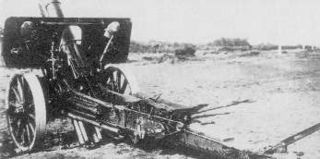 W
WThe Type 31 75 mm quick-firing gun was the main field gun deployed by the Imperial Japanese Army in the Russo-Japanese War of 1904–1905.
 W
WThe Type 38 75 mm field gun was a 1905 German design which was purchased by the Empire of Japan as the standard field gun of the Imperial Japanese Army at the end of the Russo-Japanese War. The Type 38 designation was given to this gun as it was accepted in the 38th year of Emperor Meiji's reign (1905).
 W
WThe Type 45 240 mm howitzer was a siege gun used by the Imperial Japanese Army during World War I and World War II. The Type 45 designation was given to this gun as it was accepted in the 45th year of Emperor Meiji's reign (1912). It was the first such weapon to be entirely designed in Japan.
 W
WThe 7 cm mountain gun was a Japanese ordnance first used in 1883. It was used in the First Sino-Japanese War as the main artillery, and was used again in the Russo-Japanese War by second-line troops.
 W
WThe Type 4 15 cm Howitzer was a heavy howitzer used by the Imperial Japanese Army during the Second Sino-Japanese War and World War II. The Type 4 designation was given to this gun as it was accepted in the 4th year of Emperor Taishō's reign (1915).
 W
WThe Type 38 10 cm cannon was a field gun used by the Imperial Japanese Army during World War I, the Second Sino-Japanese War and World War II. It was a licensed copy of a 1905 Krupp design. The Type 38 designation was given to this gun as it was accepted in the 38th year of Emperor Meiji's reign (1905). By 1941 it was thoroughly obsolete and relegated to second-line service.
 W
WThe Type 38 12 cm howitzer (1905) is an obsolete Japanese field piece used by the Imperial Japanese Army during World War I, Second Sino-Japanese War, and World War II. The Type 38 designation was given to this gun as it was accepted in the 38th year of Emperor Meiji's reign (1905). It was encountered by Allied forces for the first time on Iwo Jima, and it may have been used as an emergency or substitute weapon.
 W
WThe Type 38 15 cm Howitzer was a 1905 German design that was purchased by the Empire of Japan as the standard heavy howitzer of the Imperial Japanese Army at the end of the Russo-Japanese War. The Type 38 designation was given to this gun as it was accepted in the 38th year of Emperor Meiji's reign (1905).
 W
WThe Type 41 75 mm cavalry gun was a Japanese field gun first accepted into service in 1908. The Type 41 designation was given to this gun as it was accepted in the 41st year of Emperor Meiji's reign (1908). It was a slightly lightened version of the Type 38 75 mm field gun that was based on a 1905 Krupp design. It was the primary weapon of artillery units attached to cavalry formations. Although effectively obsolete by the start of World War II, it was used in limited numbers despite nominally being replaced by the Type 95 75 mm field gun.
 W
WThe Type 41 75 mm mountain gun is a Japanese license-built copy of the recoiling Krupp M1908 mountain gun. The Type 41 number was designated for the year the gun was accepted, the 41st year of Emperor Meiji's reign, 1908 in the Gregorian calendar after the conclusion of the Russo-Japanese War. Originally it was the standard pack artillery weapon. After it was superseded by the Type 94 75 mm mountain gun, it was then used as an infantry "regimental" gun, deployed four to each infantry regiment, and referred to as "rentai ho". Two gun shields were produced for the weapon, an early type, which folded into thirds, and a late type, which folded in half.
 W
WThe Type 45 15 cm cannon (四五式十五糎加農砲) was a coastal defense gun and heavy artillery used by the Imperial Japanese Army during the World War II. The designation Type 45 indicates the year of its introduction, the 45th year of the Meiji period or 1912 according to the Gregorian calendar.